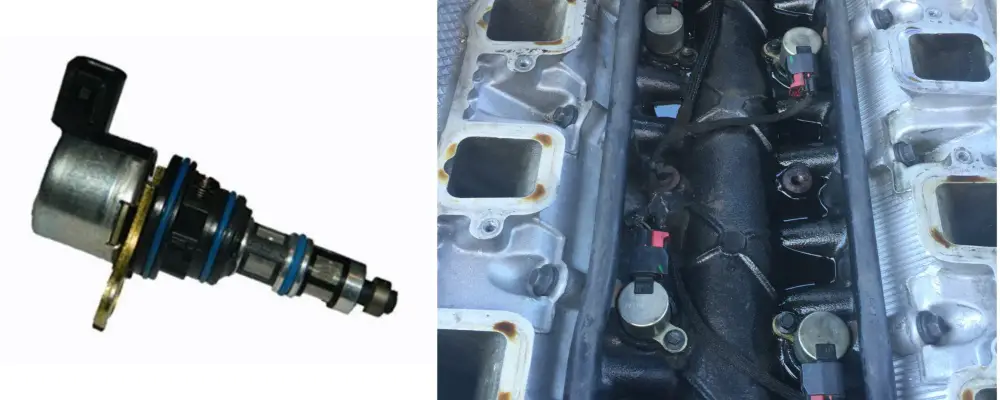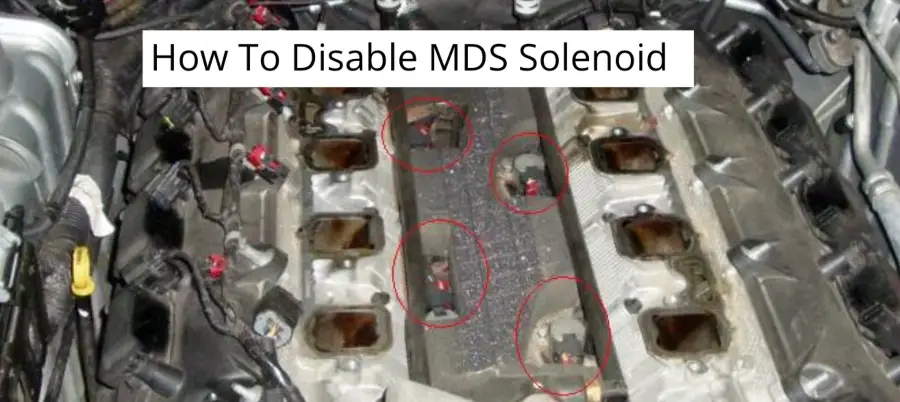
Engine components nowadays are becoming more and more complex. Each component is now heavily integrated with each other.
As such, car owners can feel whenever a component is faulty, which is especially true for something as crucial as the MDS Solenoid.
The symptoms of a faulty MDS Solenoid include bad fuel economy, surges, MDS noises, and an MDS turning on and off. These symptoms can be addressed by disabling the MDS through manual shifting or replacing the MDS solenoid in the fuel injectors.
The rest of this article will cover signs of a bad MDS solenoid in greater detail, highlighting the processes that cause your vehicle to produce such symptoms.
It’ll also guide you on how to replace a bad solenoid, so be sure to stick around to the end. Let’s dive right in.
1. Bad Fuel Economy
When the Multiple Displacement System (MDS) was introduced in 2006, its primary objective was to help save fuel. Given that it has helped car owners save an estimated 60 million gallons (227-plus million liters) of fuel annually, it’s safe to say it has been effective.
Every vehicle has cylinders that work tirelessly to provide the engine with the fuel needed for performance. Before the introduction of the MDS, these cylinders would work at the same rate regardless of driving conditions. Basically, it’s as if they were blindly pumping fuel.
The MDS’ was designed to fix that by shutting off valves and cylinders that may not be necessary under certain conditions.
Let’s say, for example, you’re driving at a speed that doesn’t require much fuel or going downhill. The MDS automatically shuts off unneeded components under these conditions to save fuel. This is why if you notice a sudden surge in fuel consumption, you’re probably dealing with a bad MDS.
The MDS doesn’t require power to work, so you probably can’t tell if it’s working. However, the fact that the MDS is mechanically passive doesn’t mean it can’t be controlled.
For illustration purposes, let’s say you’re carrying cargo or going uphill. You can put the car on “tow mode” to shut off the MDS and give your engine the fuel it needs for these demanding driving conditions. However, not all car models’ MDS can be disabled through this method.
2. Occasional Surges
Within the MDS are solenoids with the primary task of collapsing the intake and exhaust valves. These solenoids contribute to the overall goal of saving fuel and lowering emissions.
The solenoids convert electrical energy into mechanical energy and control fluid flow within the MDS with minimal supervision. If there’s excess fluid, you’ll experience occasional engine surges because the solenoids can’t effectively control fluid flow within the MDS.
3. Noisy MDS
Within the solenoid is a coil that allows the passage of electric current. The coil’s orientation creates an electromagnetic (EM) field that operates the valve. The solenoid coil is integrated into the rest of the engine via wires.
The solenoid coil wraps around a metal tube called an armature. Because it’s wrapped around the coil, the armature is at the center of the magnetic field, making it highly controllable. The armature is also connected to the valve body.
Within the armature are the plunger and the spring. If the spring is pressed down, the plunger also goes down, blocking fluid travel through the valve. The spring can only be pressed up if an electromagnetic field passes through the solenoid coil.
When these fragile components break, do expect noise due to the repeated collisions of the metal components as they move away from their original positions.
Unfortunately, it’s pretty common with complex vehicles to have such important components be brittle, as also seen in the ICP sensor on Powerstrokes.
4. MDS Turning On And Off
The solenoid is connected to a powertrain control module (PCM) that gives out commands according to driving conditions. The PCM, in a way, indirectly controls the positioning of the solenoid.
When the MDS Solenoid is not producing the performance the PCM expects from it, it may lead to the MDS powering on and off until it gives out the desired output.
Cylinder Deactivation May Hurt Your Engine
Many drivers are apprehensive about cylinder deactivation as they believe it may hurt the engine. Many complain that transitioning from having all cylinders operational to reduced cylinder functionality is not at all smooth.
As such, manufacturers rely on the PCM to execute torque-related strategies to smoothen the transition. However, this mechanism may hurt the components in the long run, particularly when the oil or the components are already dirty or damaged.
Dirty And Damaged Components May Harm the Engine
When the piston within the cylinder goes down, and the intake valve opens, air enters the cylinder and settles in front or above the piston. The piston moves up, which then compresses the air. The compressed air is then ignited via the spark plug, leading to combustion.
When the cylinder is deactivated, the piston moves back down, and the intake valve is closed. The exhaust valve is also closed, trapping the gases inside the cylinder. While efficient, This repeated switch-on-switch-off motion has led to engine wear, particularly on older models.
Odd-Number Cylinders Are Prone To Uneven Vibrations
There’s a reason the number of cylinders in cars tends to be even. Having cylinders in even numbers ensures when one cylinder is deactivated, another is also deactivated. This alternation helps balance out the pressure directed to the crankshaft.
If a cylinder stops in the middle of gas compression, its counterpart cylinder pushes the piston down to simulate a gas intake. With 3-cylinder vehicles in particular, pressure and vibrations tend to be unbalanced, which also leads to engine wear.
Modern engines, however, have taken into account this design flaw. So, expect to see no to minimal wear under the MDS.
How To Temporarily Disable the MDS

If the solenoid prevents your car from working normally, and you’re wary of cylinder deactivation’s effect on your engine, you can temporarily disable the MDS.
I’ve already mentioned that the MDS is still a controllable system despite being mechanically passive. However, the Tow Mode button only works on a 6-cylinder system and not on an 8-cylinder.
For the six-cylinder, you can use your shifter for disabling. In some vehicles, you can pull the shifter all the way down and tug it to the left. This puts it in manual shift mode. Keep tugging the shifter until you see that all six gears are activated.
There are some models, however, with different mechanisms. Some employ knobs to shift cylinders. If you have a vehicle with this mechanism, you will have to use the buttons found on the steering wheel.
Press the negative button on the steering wheel or the down button to enter shift mode, then press the up or the positive button. Keep on pressing until you activate all the gears in your vehicle.
The same steps can be applied to vehicles with column shifters. Locate the negative button you need to put in shift mode and press the positive button until all gears are activated.
Once done, you will notice that the MDS will stop working. This is temporary. Do note that you may encounter fuel surges with continued MDS disabling.
How To Replace the MDS Solenoid
In some cases, you’re better off replacing the MDS Solenoid altogether. Here’s a step-by-step guide on how to do this properly:
- If you have already taken out the engine, lay it on a flat surface. You should be able to see wires connected to six solenoids. Disconnect the solenoid from the wires. Adjacent to the solenoids are screws you will have to loosen but not altogether remove.
- If you use an adjustable wrench and pull the solenoid upwards, you will end up taking the top of the solenoid valve out. The armature and plunger will still be stuck inside. The armature can be pulled out. It’s a thin piece of metal you can access when you take the top of the solenoid out.
- To remove the rest of the solenoid, get a screw (preferably hex head) that has a similar diameter to the top of the armature and screw it into the solenoid using the box end. You’re good to go once it is tightly within the solenoid. The screw adjacent to the solenoid wasn’t removed because it keeps it from moving around.
- Using a clawhammer, pry out the entire solenoid with the help of the screw. Use the end on the side of the hammer’s head for additional support. That should make the solenoid easily pop out. Also, the adjacent screw should be removed alongside the entire solenoid.
- Follow the same steps if you wish to remove more solenoids. Take your replacement MDS solenoid and place it in using your hands. Tighten using an adjustable wrench.
I would advise you to keep extra solenoids in case one or more fail again. Try to keep a toolbox within your car so that you can do repairs even when in transit.
If you prefer video, I found this video very helpful:
